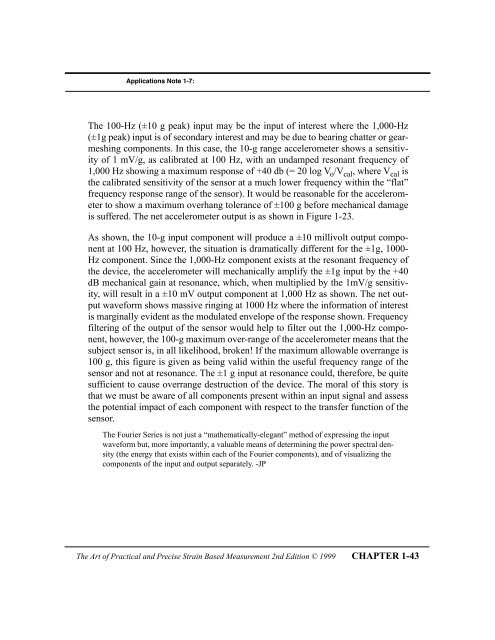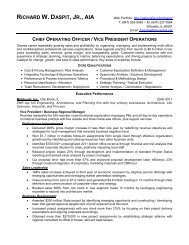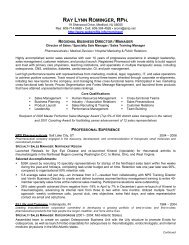The Art of Practical and Precise Strain Based ... - Webprofile.info
The Art of Practical and Precise Strain Based ... - Webprofile.info
The Art of Practical and Precise Strain Based ... - Webprofile.info
- No tags were found...
You also want an ePaper? Increase the reach of your titles
YUMPU automatically turns print PDFs into web optimized ePapers that Google loves.
Applications Note 1-7:<strong>The</strong> 100-Hz (±10 g peak) input may be the input <strong>of</strong> interest where the 1,000-Hz(±1g peak) input is <strong>of</strong> secondary interest <strong>and</strong> may be due to bearing chatter or gearmeshingcomponents. In this case, the 10-g range accelerometer shows a sensitivity<strong>of</strong> 1 mV/g, as calibrated at 100 Hz, with an undamped resonant frequency <strong>of</strong>1,000 Hz showing a maximum response <strong>of</strong> +40 db (= 20 log V o /V cal , where V cal isthe calibrated sensitivity <strong>of</strong> the sensor at a much lower frequency within the ÒflatÓfrequency response range <strong>of</strong> the sensor). It would be reasonable for the accelerometerto show a maximum overhang tolerance <strong>of</strong> ±100 g before mechanical damageis suffered. <strong>The</strong> net accelerometer output is as shown in Figure 1-23.As shown, the 10-g input component will produce a ±10 millivolt output componentat 100 Hz, however, the situation is dramatically different for the ±1g, 1000-Hz component. Since the 1,000-Hz component exists at the resonant frequency <strong>of</strong>the device, the accelerometer will mechanically amplify the ±1g input by the +40dB mechanical gain at resonance, which, when multiplied by the 1mV/g sensitivity,will result in a ±10 mV output component at 1,000 Hz as shown. <strong>The</strong> net outputwaveform shows massive ringing at 1000 Hz where the <strong>info</strong>rmation <strong>of</strong> interestis marginally evident as the modulated envelope <strong>of</strong> the response shown. Frequencyfiltering <strong>of</strong> the output <strong>of</strong> the sensor would help to filter out the 1,000-Hz component,however, the 100-g maximum over-range <strong>of</strong> the accelerometer means that thesubject sensor is, in all likelihood, broken! If the maximum allowable overrange is100 g, this figure is given as being valid within the useful frequency range <strong>of</strong> thesensor <strong>and</strong> not at resonance. <strong>The</strong> ±1 g input at resonance could, therefore, be quitesufficient to cause overrange destruction <strong>of</strong> the device. <strong>The</strong> moral <strong>of</strong> this story isthat we must be aware <strong>of</strong> all components present within an input signal <strong>and</strong> assessthe potential impact <strong>of</strong> each component with respect to the transfer function <strong>of</strong> thesensor.<strong>The</strong> Fourier Series is not just a Òmathematically-elegantÓ method <strong>of</strong> expressing the inputwaveform but, more importantly, a valuable means <strong>of</strong> determining the power spectral density(the energy that exists within each <strong>of</strong> the Fourier components), <strong>and</strong> <strong>of</strong> visualizing thecomponents <strong>of</strong> the input <strong>and</strong> output separately. -JP<strong>The</strong> <strong>Art</strong> <strong>of</strong> <strong>Practical</strong> <strong>and</strong> <strong>Precise</strong> <strong>Strain</strong> <strong>Based</strong> Measurement 2nd Edition © 1999 CHAPTER 1-43
















